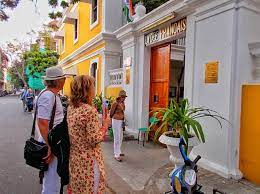Find the Charming Provincial Design of Pondicherry! Pondicherry, otherwise called Puducherry, is a city in Southern India that holds a rich provincial history reflected in its momentous design. Venturing into the roads of Pondicherry resembles venturing back in time, as its pleasant structures feature an exceptional mix of French, English, and Indian impacts. The French Quarter, otherwise called the White Town, is the core of Pondicherry’s provincial legacy. Its cobblestone roads and tree-fixed lanes are embellished with flawless structures painted in shades of pastel tints, suggestive of the French open country. Strolling through these roads, one can’t resist the urge to feel moved to an alternate period. The French Quarter is home to various frontier chateaus, known as “manors,” that feature perfect engineering subtleties like curved entryways, luxurious galleries, and fantastic yards. The combination of French and neighborhood Tamil styles is obvious, making a remarkable structural personality.
The gem in the crown of Pondicherry’s provincial design is without a doubt the famous French Organization, usually known as Coalition Française. This rich structure grandstands an ideal mix of Indo-French design. Its elegant curves, high roofs, and rich nurseries radiate a demeanor of refinement and social liveliness. The French Establishment fills in as a center for language and social trade, facilitating workmanship displays, theater exhibitions, and studios. It remains as a demonstration of the getting through French impact in Pondicherry. ️Another engineering pearl in Pondicherry is the Basilica of the Holy Heart of Jesus. This radiant church, with its Gothic-enlivened engineering, remains as a demonstration of the city’s provincial past. Its striking stained glass windows, transcending towers, and perplexing carvings attract guests with their remarkable excellence. Inside the basilica, a serene vibe wins, welcoming guests to reflect and value the combination of European and Indian building styles.
As you investigate Pondicherry, you’ll run over the stupendous Raj Nivas, the authority home of the Lieutenant Lead representative. This eighteenth century building features a mixture of French and Indian design components. With its perfect white façade, exquisite corridors, and all around manicured gardens, Raj Nivas radiates magnificence and appeal. The structure is a design wonder that stands as an image of force and authority. Pondicherry’s pilgrim engineering isn’t restricted to terrific public structures; it stretches out to beguiling bistros, store lodgings, and workmanship displays that speck the roads. These foundations have embraced the city’s building legacy by safeguarding the pioneer structures and integrating them into their plans. This mix of old and new makes an interesting environment that catches the substance of Pondicherry’s social personality. Taking everything into account, the pilgrim engineering of Pondicherry is a charming demonstration of its set of experiences and social variety. The combination of French, English, and Indian impacts makes a particular visual embroidery that keeps on spellbinding guests from around the world. Investigating the roads of Pondicherry is an excursion through time, where each building recounts an account of the city’s provincial past.
https://narrativeby.com/the-colonial-architecture-of-pondicherry/



